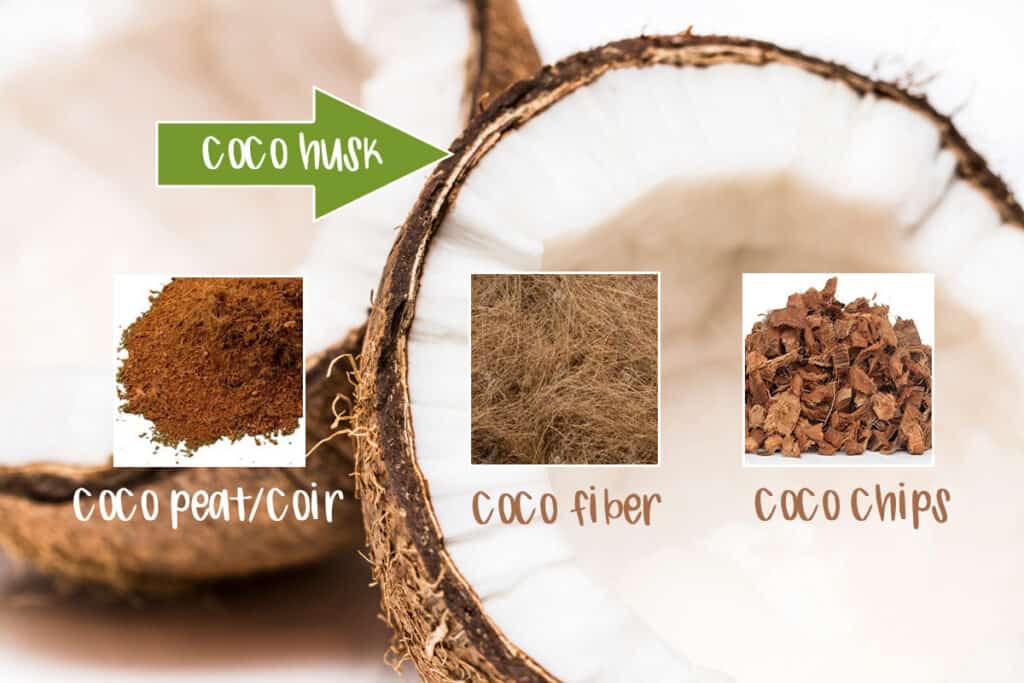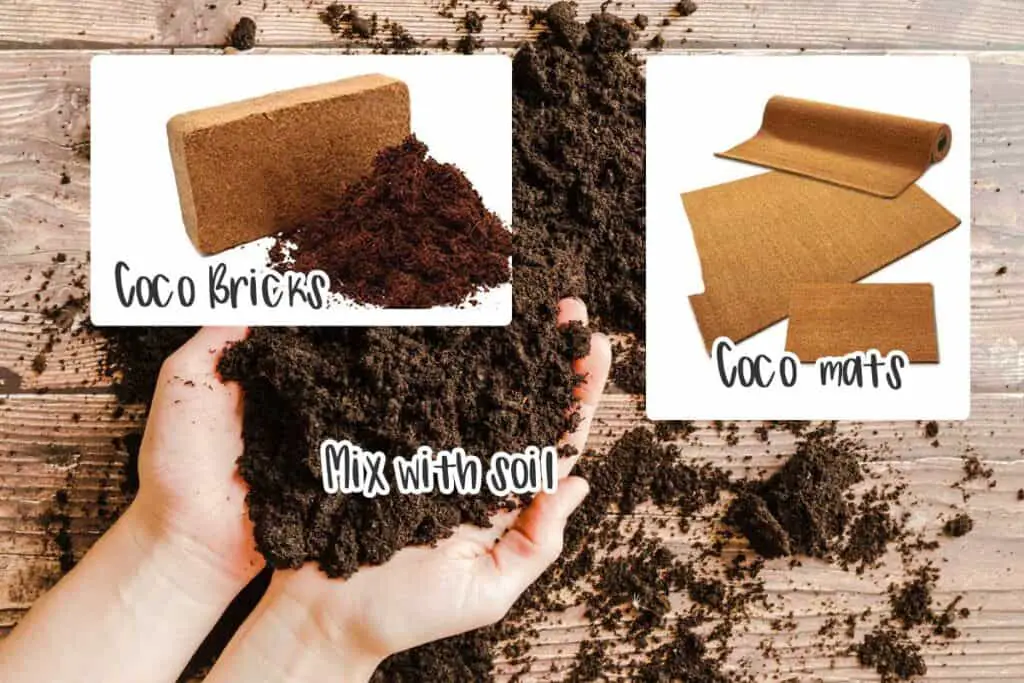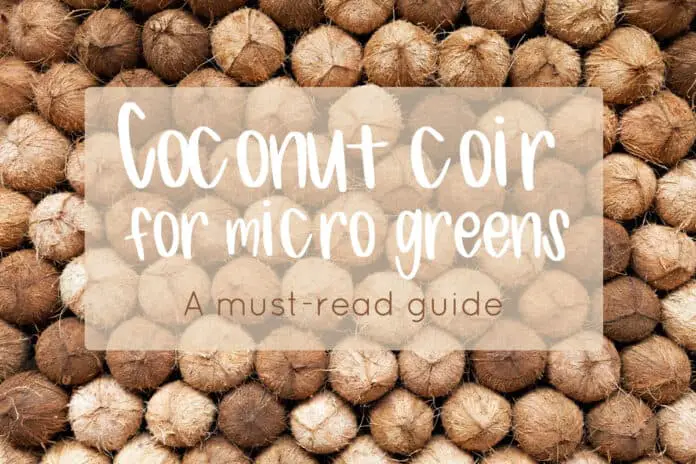Coconut coir has taken the gardening world by storm and it’s popular for its use as a medium to grow microgreens. It has been used for long by growers in countries where coconut grows naturally. With its diverse benefits, it’s no wonder we are keen to use it for our microgreens.
In this article, we’ll explain the greatness of coconut coir, guide you through the process for how to use it correctly for growing microgreens, and help you select some high-quality products.
Let’s first start by understanding what it is and why it’s such a great growing medium.
What is coconut coir?
Coconut coir is a lightweight soilless medium made from coconut husks. It’s the substance that you will find in the coconut, between the outer coating to the inner shell. It’s a dark brown and fibrous material with fibers that are very strong and easily managed.
While it used to be considered only a by-product of the coconut industry and having no purpose, it has proven to have fantastic value as an eco-friendly and recognized growing medium. You can plant microgreens directly in coconut coir or mix it with other mediums such as soil.
Types of coconut material
You can get the coconut material in different textures and shapes; as a mat, dried and pressed into bricks which expands when water is added or bagged up as organic mulch. (A mulch is a layer of material applied to the surface of the soil for healthier growths and to resist drought).
You may come across different types of products made from coconut. The more common are peat, fibers, and chips. The products produced vary for a variety of gardening uses. Let us explain the difference between the three varieties:
Coco peat/coir – This looks similar to peat moss. It’s made from the coconut husk and then grounded so it gives you the finer chopped coconut coir. You will find that the medium is very granulated.
Coco fibers – These are the long fibers which have not yet been chopped and ground up. These are often used as a mulch or topper.
Coco chips – Coco- Chips are churns of coconut husk. This when the coco is ground up but not down to soil-like texture. It looks like small wooden pieces and they are commonly used also as a mulch.

What are the benefits of using coconut coir?
So why all the fuzz about coconut coir? There are many great benefits of using coconut coir as a growing medium for microgreens. Coconut coir can be used as a stand-alone medium or mixed in with other mediums such as soil or perlite.
Some of the great things about using coconut coir for growing microgreens are:
- It’s 100% organic – It’s really earth-friendly as it’s a completely natural and renewable resource. This makes it an excellent eco-friendly option for environmental sustainability.
- Water retention – One of the key benefits of using coconut coir is its ability to retain water. It has high water holding capacity but at the same time maintaining excellent drainage which makes it ideal to mix in with soil.
- Neutral PH – It has a neutral PH level which is important for healthy growth. “The pH level makes the difference between having a grow room full of nutrient-healthy, thriving plants, and seeing your time, effort, and money end up as little more than a compost waste pile!” Source: Advance Nutritients
- It’s odorless – It doesn’t create any foul smells and therefore ideal for indoor growing.
- Bacteria free – It’s free of bacteria and weed seeds which will help microgreens from developing mold and other diseases.
- Strong root growth – It gives the roots plenty of room and provides excellent air exposure. It offers a great combination of water retention, reliable drainage, and ideal aeration.
Summing up the above, you can see that coconut coir has so many benefits. The only negative that we have found, which you may take into consideration, is that due to its nature it doesn’t contain any nutrients but only potassium which helps seedling grow well. For this reason, you may want to add some fertilizer when using this medium as a stand-alone.
As a mixin with soil, coconut coir is commonly replacing peat moss and the great benefit is that it’s cheaper and more sustainable with higher water retention.
How do you grow microgreens with coconut coir?
So now when we know all the awesomeness around coconut coir, let us take you through the growing process step-by-step. We’ll take you through the steps to grow using mats, bricks, and mixed in with soil. These three alternatives are all excellent for growing microgreens.

Using Coconut coir mats
Getting coconut coir as a mat is ideal for growing microgreens. You buy normally the mats in rolls and cut them in the size to fit your trays. The mats hold moisture great and roots grow through the coir mats easily.
How to prepare the growing mat for microgreens
- Select the tray – Decide the tray you want to use.
- Cut the mat into size – Cut the mat in the size so it fits your tray. Depending on the thickness of the mat you can use normal scissors or a utility knife.
- Add water – Place the mat in the tray and then add water so it soaks. Let the mat sit for at least 30-60 minutes. When it has absorbed moisture, wring them out thoroughly.
- Soak again – Empty any excess water, and then repeat the process to soak for another 30-60 minutes. If there is any excess water, you can lightly squeeze the mat.
- Sprinkle the seeds – You are now ready to sprinkle to the microgreens into your trays. Follow the instructions for the blackout period and germination based on the seeds you are growing.
Using Coconut coir bricks
Coconut coir can be bought compressed in bricks. Before you can start to use it you have to prepare it. To get your coconut coir ready to be used as a growing medium you have to expand it.
How to prepare the coconut coir bricks for microgreens
- Select the tray – Decide the tray you want to use. Remember that coconut coir can absorb as much as ten times its weight in water, so ensure you have a tray to fit the final result. Depending on the size of the brick you may even want to put it in a larger tote or similar and then store the remaining coir after you have taken what you need for your tray.
- Soak your bricks – place the brick into the tray or other container and start by adding water and let it absorb all the water. It will make the coir to expand about 10 times its volume. Add additional water as necessary for the entire brick to expand.
- Fluff the coir – Once the coconut coir has taken in all the water, you will find how easily it breaks down into fibers. Separate the fibers with your fingers to get a nice and even medium. If you find that parts of the brick have not broken down you can just add some more water to it.
- Store excess coir – Once the coconut coir has expanded it’s ready for use. Depending on the size of your brick you may end up with more coconut coir than you can use. You can then simply store it in plastic bags and you will have it ready for future use.
- Mix with perlite (optional) – Since coconut coir has such high water retention it’s popular to mix it with some perlite. Perlite is used to provide air around the roots of plants and to both help retain water and improve drainage. 70% coconut coir and 30% perlite mixture is a good ratio.
- Fill up your tray – Start by placing the coconut coir (with or without perlite) evenly spread out in a tray with holes. Fill up the tray to about 2/3 of its full volume. We’d recommend placing this tray in another one without holes. This will then allow you to put the water in the bottom tray and the coconut coir will soak it up from underneath.
- Add fertilizer – You can add some fertilizer into the water to promote healthier growth.
- Sprinkle the seeds – Spread out your microgreen seeds evenly across the tray. Depending on the type of seeds you use, you may have to add another layer of coconut coir on top. Follow the instructions for the blackout period and germination based on the seeds you are growing.
TIP: You can experiment with a small amount of coco coir and add a cup of water to get a feel for how much is needed to get the desired expansion. As the coco coir absorbs the water, add more water until it’s fully saturated. If you have too much water, just squeeze it out with your hands.
Mix with soil
You can also use coconut coir to mix with soil. It doesn’t matter what type of soil you use, adding coconut coir will support loosening the texture and improve drainage. Adding coconut coir to your soil improves the growing conditions as it supports water retention.
How to prepare the soil mix
- Mix in with soil – You mix your coconut coir with the soil you are going to use. Take approximately 1/3 coconut coir and 2/3 compost/soil. These ingredients will provide an excellent medium.
- Add fertilizer – You can also, later on, add a supplement such as a liquid fertilizer as the microgreens mature past germination.
- Fill up your tray – Fill a tray with your soil mix and save the rest of the soil you are not using in a sealed plastic bag.
- Sprinkle the seeds – You are now ready to spread out your microgreens seeds. Depending on the type of seeds you may need to cover them with further soil or add some damp paper towel to support the germination process. Follow the instructions for the blackout period and germination based on the seeds you are growing.
- Water your soil mix – You have to be careful not to overwater the medium because of its water retention. You want the coconut coir to be wet, but not saturated.
Selecting the best coconut coir
Now when you know what coconut coir is and why it’s a great medium to chose for growing microgreens, we’ll share some factors to consider and which can help you find the best product.
Price
If you are buying your coconut coir online, the most economical option is to go for bricks. You will then get your medium dehydrated and compressed and not in a huge sack which will make shipping more expensive.
Buying it loosely means high volume and heavy sacks, similar to soil. When you buy coconut in brick it has a very high compression ratio, so when you put it in water it will expand and give you a high volume of growing medium. Coconut coir expands up to ten times its own weight.
When it comes to how much it costs to grow in coconut coir, we’d say that it costs about $0.80 per tray in general.
Recognized brands
There are many options available on the market and it can be a challenge to know which options to go for. We have listed some brands which we have researched and found offering good quality products.
Mountain Valley Seed Co. – Minute Soil
These smaller bricks sold by True Leaf Market are great for smaller crops and home growers. If you don’t want to buy a bigger lot, this is an excellent choice.
They contain pure, untreated, raw fibrous coconut coir that is compressed into light convenient discs or blocks that quickly expand into an amazing grow medium when you add water. Minute soil has tremendous water retention capabilities that both save water and gives you added flexibility in watering frequency.
Plantonix Coco Coir Bricks
These bricks from Plantonix are 100% natural and organic. They provide plenty of aeration and drainage and contains only coconut pith and fibers. You can buy them in packs with 3, 5 and 10 bricks. They are lightweight; 1 brick weighs 635 grams (23oz).
Buy Plantonix Coco Coir Bricks
Mother Earth 100% coconut fiber
This is a readymade mix of coconut coir and perlite. It’s made from natural washed Coco Fiber. This unique mix incorporates 70% of the finest coconut pith and fiber blend. Also, it incorporates 30% perlite for better aeration and drainage. It comes in a 50L package so shipping cost may be considered.
Can you reuse coconut coir for microgreens?
Coconut coir is a medium that takes longer to fully break down therefore you may wonder if it can be reused instead of going to landfills.
You can compost if you feel it’s too beaten up and use it later for your outdoor garden. We wouldn’t use it again for growing microgreens but as mentioned, you can definitively compost it, mix it with soil, and get a new medium to use for growing outdoors.
RELATED: Should You Reuse Microgreen Soil?
Best microgreens to grow in coconut coir
With all the different varieties of microgreens, there is, you may wonder which ones are the best for growing in coconut coir.
As it has more or less the same texture as the soil you can grow basically any microgreens in this medium.
Using a growing mat you may consider it for smaller seeds such as broccoli and radish. Larger seeds like sunflowers may have the challenge to settle into the medium.
Final thoughts
Coconut coir is a great medium in many ways. We love to use it not only as it’s ecological and environmentally friendly but because it is cost-effective and gives good growth. It’s also very clean to work with using the growing mat.
Depending on how you want to grow your microgreens, using coconut coir can be beneficial in many ways. This abundant, renewable resource is a great addition to the soil to improve water retention, makes an excellent substitute for peat, and last but not least it’s a hydroponic support medium.
Happy growing!




I initially was attracted to coir as a substitute for peat moss, which is highly unsustainable. But it seems that coir may be problematic in the way it’s processed, and in the effects this work has on workers. There are several articles around on the topic; one at gardenmyths dot com is typical and it lists its sources. Peat, coir, perlite, vermiculite – it’s all a bit maddening. Some combination of all or some of these substances seem to be a part of all the mixes I look at. Can one simply do without them and still have a workable media?
Hi J. Palmer
You can replace any of the mediums you have mentioned, and instead grow in organic potting soil, on a paper towel, or using just plain water. The two latter methods have their challenges. For growing in water only, you need a mesh tray. Not all seed types will grow well using only water with no medium. Depending on the seed size, be careful so they don’t fall through the net.
You can also use a paper towel as a medium, however, the main challenge is that the roots will have a harder time pushing through the paper. This may have an impact on the length and fullness of the microgreens, compared to growing in soil.
Try out the different methods and see which one you prefer. Let us know how it works out!
I have had success with terrafibre hemp fiber grow mats [email protected]